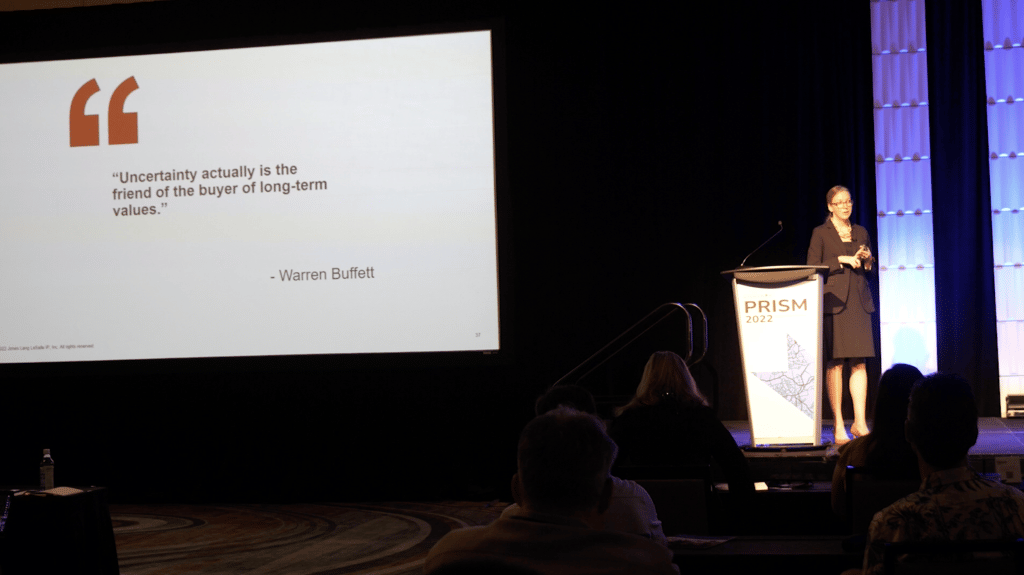LightBox’s Fall 2022 Consumer Sentiment Report notes that “Significant market headwinds, including a slowdown in economic momentum, rising interest rates, ongoing supply chain disruption, labor shortages and the threat of a recession are adversely impacting investor sentiment heading into the year-end.” In a keynote presentation at LightBox’s recent PRISM conference, Julia Georgules, head of research for the Americas at JLL, looked at what lies behind these trends and shared her views on inflation, the labor market, sustainability, and the office and home sectors.
According to Georgules, inflation is creating headwinds in today’s economy, and demands a successful response because it’s not sustainable. A number of factors are driving inflation, including record corporate earnings and profits, a tight labor market, a significant battle for talent, and the war between Russia and Ukraine. Growing retail sales are leading to supply chain problems. To meet demand, retailers are boosting inventories. Some have become oversupplied, though this should balance out over time.
The labor market remains challenging. During the past decade, the 10-year average for job openings was around five million. That increased about six months into the pandemic, and the average number of job openings has now doubled to about 10 million. In addition, people want better working conditions and wages. Some aren’t returning to the labor market at all, affecting service industries such as leisure and hospitality. Labor force participation is at a 22-year low. Long term, we will continue to face labor shortages in the economy, but they will prompt innovation, optimization, and new ways to do things.
Another big question in real estate is related to demographics: Where are people moving, and what cities are they leaving? The population is shrinking in the Northeast and the Midwest, and it’s growing in the South and the East. Some of this is because of weather, business-friendly climates, and better quality of living. Migration patterns have given way to new and emerging markets that are growing and benefiting the dynamics of new company formation, expansion, and demand for goods and services.
Global warming will make our lifestyles more challenging. It’s imperative that we focus on sustainability. Roughly 60 percent of carbon emissions in the U.S. come from buildings, making it essential for the commercial real estate industry to focus significantly during the next 30 years on making buildings net-zero emitters. We can provide offsets through renewable energy powered through the building, but until the full grid becomes renewable, it will be hard to achieve this goal.

The office sector plays a key role in the economy. As the pandemic recedes, companies have become comfortable with hybrid work; many are asking their employees to be in the office two or three days a week. As a result, leasing activity has recovered, though it’s still about 15 million square feet below the long-term average. Many headlines report that vacancies are at all-time highs because companies are going fully remote. But if you dig deeper, that’s actually not the case.
Vacancies are higher, but that’s because we’re seeing a significant flight to quality, a trend that started before the pandemic. There is bifurcation in market performance based on properties built before 2015 and those built after—basically, new versus old. New construction has outperformed the market while older buildings have seen occupancy losses. Surveys show that employees not only want flexibility in their schedules, but also in how they use office space. So, there are essentially two markets: high-quality, high-end real estate that is in limited supply—and with stubbornly low vacancy rates—and older buildings that aren’t meeting the demands of the current workforce.
The housing market faces a major impact from interest rates. During the last 30 years, household formation rates increased. A lot of people speculated that millennials would never get married, have kids, or move to the suburbs—but they are doing just that. However, the last recession burned us in terms of housing supply. We haven’t built enough and that’s becoming acutely painful from an affordability perspective.
What this means for the multi-housing sector is that affordability for single-family homes will remain elevated, and with higher interest rates it’s becoming more challenging for people, especially first-time buyers, to purchase a home. It’s simply more affordable to rent and stay in cities.
From the sustainability perspective, there are many benefits to urban density. The cost of living improves because you have access to more services, you’re not paying for transportation, and you’re closer to work so you have a shorter commute. These and other qualities make cities very attractive today for young talent.
Finally, it’s important to remember that cycles and trends will always come and go. Real estate is a durable business: People will always need places to live, to work, to store goods, and to provide services—and they will try to do so in the best locations and in the highest quality properties. This will keep the industry viable for the long term.
Check out the LightBox PRISM Resource Hub
